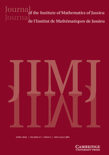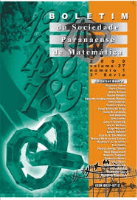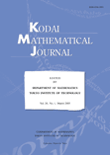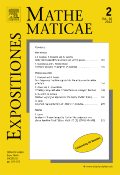
SIAM Journal on Applied Algebra and Geometry
Scope & Guideline
Connecting Theory to Practice in Mathematical Research
Introduction
Aims and Scopes
- Algebraic Geometry Applications:
Research that explores the practical implications of algebraic geometry in solving real-world problems, particularly in areas like coding theory and optimization. - Geometric Modeling and Optimization:
Studies focused on using geometric principles to develop robust models for optimization problems, particularly in engineering and computational contexts. - Statistical and Computational Methods:
Papers that investigate the intersection of statistical models and algebraic methods, providing new algorithms and computational techniques for data analysis. - Persistent Homology and Topological Data Analysis:
Research that employs concepts from algebraic topology, particularly persistent homology, to analyze and extract features from complex data structures. - Coding Theory and Algebraic Structures:
Exploration of various coding theories, including the construction and analysis of codes derived from algebraic and geometric principles.
Trending and Emerging
- Machine Learning and Neural Networks:
There is a growing trend towards the application of algebraic and geometric methods in machine learning, particularly in the development of new algorithms and models that leverage neural network architectures. - Topological Data Analysis (TDA):
The integration of topological concepts, particularly persistent homology, into data analysis is becoming increasingly prominent, showcasing the utility of algebraic topology in extracting meaningful insights from complex datasets. - Robust Statistical Models:
Research focusing on the development of robust statistical models that incorporate algebraic techniques is rising, indicating a shift towards more reliable and interpretable statistical methodologies. - Geometric Approaches to Optimization:
There is an uptick in studies that employ geometric methods to tackle optimization problems, highlighting the importance of geometric intuition in algorithm design. - Interdisciplinary Applications:
The journal is increasingly publishing papers that apply algebraic and geometric techniques to diverse fields such as biology, physics, and engineering, reflecting a broader application of its core methodologies.
Declining or Waning
- Traditional Algebraic Structures:
Research focusing on classical algebraic structures, such as rings and fields, appears to be waning as the focus shifts towards more applied and computational aspects of algebra. - Elementary Geometry:
Topics centered around basic geometric constructs and their properties are becoming less frequent as the journal increasingly emphasizes advanced geometric modeling and applications. - Purely Theoretical Computer Science:
Papers that delve into theoretical aspects of computer science without a strong algebraic or geometric application are seeing a decline, as the journal's focus shifts towards interdisciplinary applications.
Similar Journals

CUBO-A Mathematical Journal
Advancing Knowledge Across Mathematical DisciplinesCUBO-A Mathematical Journal, published by the Department of Mathematics and Statistics at Universidad de La Frontera in Chile, stands as a significant Open Access resource in the field of mathematics since its inception in 2011. With an ISSN of 0716-7776 and an E-ISSN of 0719-0646, this journal invites submissions that explore a wide spectrum of mathematical disciplines, including Algebra, Number Theory, Analysis, Geometry, Topology, and Logic. Although currently positioned in the Q4 category across various mathematical domains and registered at Rank #223/399 in General Mathematics in Scopus, CUBO serves as a valuable platform for emerging researchers and practitioners to disseminate their findings. Operating under a continuous commitment to accessibility, CUBO fosters an inclusive academic environment that supports the exchange of innovative ideas vital to advancing mathematics. The journal's target audience encompasses a diverse community of researchers, professionals, and students eager to participate in the expanding dialogue within mathematical sciences.

Journal of Homotopy and Related Structures
Charting New Territories in Mathematical RelationshipsJournal of Homotopy and Related Structures is a distinguished academic journal published by Springer Heidelberg, specializing in the fields of algebra, number theory, geometry, and topology. With a focus on the intricate relationships and structures within these disciplines, the journal aims to facilitate the dissemination of original research and provide a platform for scholarly exchange among mathematicians. Since its inception in 2012, the journal has positioned itself in the Q2 category for both Algebra and Number Theory and Geometry and Topology in 2023, reflecting its growing influence and commitment to high-quality publications. Although it operates under a subscription model, the research published in this journal is highly cited, contributing to its notable rankings—#57 in Geometry and Topology and #65 in Algebra and Number Theory on the Scopus index. This journal is an essential resource for researchers, professionals, and students who wish to stay updated with the latest advancements and trends in homotopy theory and related mathematical structures.

Advanced Studies-Euro-Tbilisi Mathematical Journal
Advancing Mathematical Knowledge GloballyAdvanced Studies-Euro-Tbilisi Mathematical Journal, published by the esteemed TBILISI CENTRE MATH SCI, is a vital resource for scholars and practitioners in the field of mathematics. Since its inception in 2021, this journal has committed to advancing knowledge across various mathematical disciplines, including Algebra and Number Theory, Analysis, Applied Mathematics, and Geometry and Topology, although it currently holds a category quartile ranking of Q4 in all these areas. With an open-access format, it provides unparalleled access to cutting-edge research to a global audience of researchers, professionals, and students, fostering collaboration and innovation within the mathematical community. Operating from TBILISI, Georgia, the journal acknowledges the growing importance of diverse geographical contributions to mathematics and aims to spotlight emerging research trends. As research continues to evolve, Advanced Studies-Euro-Tbilisi Mathematical Journal seeks to enrich the academic dialogue and support the dissemination of mathematical knowledge.

Journal of the Institute of Mathematics of Jussieu
Connecting Scholars Through Cutting-edge Mathematical ResearchJournal of the Institute of Mathematics of Jussieu, published by Cambridge University Press, is a leading academic journal that has established itself as a vital resource in the field of mathematics. With an impressive impact factor and a ranking in the top quartile (Q1) of miscellaneous mathematics, the journal serves as a platform for high-quality research from both established scholars and emerging researchers. Spanning from 2002 to 2024, the journal aims to foster collaboration and innovation in the mathematical community by publishing original research articles, reviews, and critical discussions on a wide range of mathematical topics. Although the journal does not offer open access, it remains widely accessible through various academic institutions and libraries, ensuring that critical advancements in mathematics are shared with a global audience. Located in the United Kingdom at the prestigious Cambridge campus, the journal reflects the rigorous standards of its publisher and the rich academic tradition of its home institution.

Boletim Sociedade Paranaense de Matematica
Unlocking the Future of Mathematical InquiryBoletim Sociedade Paranaense de Matematica is a distinguished journal within the field of Mathematics, published by the Sociedade Paranaense de Matemática in Brazil. With an ISSN of 0037-8712 and an E-ISSN of 2175-1188, this journal has been committed to fostering open access to mathematical research since 2002, ensuring that cutting-edge research is readily available to the academic community. Operating within the diverse landscape of mathematical studies and ranked Q3 for 2023 in the category of Mathematics (Miscellaneous), the journal serves as a platform for innovative contributions and discussions. It ranks 192nd out of 399 in the Scopus database for General Mathematics, reflecting its steady involvement in the global academic dialogue. The Boletim resides at JD AMERICAS, CAIXA POSTAL 19081, CURITIBA PR 81531-990, Brazil, and aims to connect researchers, practitioners, and students by promoting high-quality research and dissemination of mathematical knowledge. By bridging diverse mathematical theories and applications, the journal not only enhances understanding of the discipline but also drives future research directions.

Cambridge Journal of Mathematics
Exploring Innovative Solutions in MathematicsCambridge Journal of Mathematics, published by INT PRESS BOSTON, INC, is a premier platform for the dissemination of cutting-edge research in the field of mathematics. With an ISSN of 2168-0930 and E-ISSN 2168-0949, this journal stands out in a competitive academic landscape, currently ranked #58 out of 399 in General Mathematics, placing it in the top 15% within its category according to Scopus metrics. The journal serves as a vital resource for researchers, professionals, and students alike, aiming to foster groundbreaking mathematical inquiries and foster collaboration across disciplines. Published from 2020 to 2024, the Cambridge Journal of Mathematics is committed to maintaining high standards of scholarship, making it an essential read for those who are passionate about advancing mathematical knowledge and its applications.

Korean Journal of Mathematics
Nurturing Excellence in Mathematical Inquiry.The Korean Journal of Mathematics, published by the Kangwon-Kyungki Mathematical Society, is an esteemed platform dedicated to advancing the field of mathematics. With an ISSN of 1976-8605 and E-ISSN of 2288-1433, the journal features a range of scholarly articles that emphasize both theoretical and applied aspects of mathematics, catering to researchers, professionals, and students alike. Although it is not open access, the journal maintains a commitment to academic rigor and integrity, ensuring high-quality contributions to the mathematical community. As it converges from years 2021 to 2024, the Korean Journal of Mathematics is poised to enhance its visibility within the Scopus database, currently ranking #354 out of 399 in the general mathematics category, reflecting its potential for growth and impact in the mathematical sciences. With its strategic focus and institutional backing from Kangwon National University, the journal serves as a vital resource for fostering research and dialogue in the ever-evolving landscape of mathematics.

Kodai Mathematical Journal
Advancing Mathematical Frontiers Since 1949Kodai Mathematical Journal is a distinguished publication dedicated to advancing the field of mathematics, particularly in miscellaneous areas. Established in 1949, this esteemed journal has been a reputable source for researchers and practitioners who seek to contribute to the rich landscape of mathematical knowledge. Published by KINOKUNIYA CO LTD, the journal is based in the academic environment of Tokyo Institute of Technology and serves a global audience with rigorous and insightful research articles. Despite its current Q3 quartile ranking in the Scopus Mathematics category, which reflects its niche but impactful contributions, the journal is poised for growth; the convergence of traditional and novel mathematical techniques promises to enhance its relevance further. Researchers, professionals, and students are encouraged to engage with the rich content of the journal, aimed at fostering collaboration and nurturing innovation in the mathematical community. While currently not available as Open Access, Kodai Mathematical Journal remains a critical resource for those passionate about mathematics and its applications.

EXPOSITIONES MATHEMATICAE
Fostering Original Research in Diverse Mathematical FieldsEXPOSITIONES MATHEMATICAE, published by Elsevier GmbH, stands as a significant journal in the realm of mathematics, catering primarily to researchers, professionals, and students. With an ISSN of 0723-0869 and an E-ISSN of 1878-0792, this journal has made its mark in the academic community, boasting a Q2 classification in the miscellaneous mathematics category for 2023, illustrating its prominence within its field. The journal addresses a diverse scope of mathematical topics, encouraging the publication of original research and innovative theories while maintaining rigorous academic standards. As it converges from 2004 to 2024, EXPOSITIONES MATHEMATICAE continues to be an essential resource for advancing mathematical knowledge and fostering scholarly communication, despite being a non-open-access publication. Its location in Munich, Germany further anchors it within a rich intellectual tradition, providing accessibility for the mathematical community worldwide.

Selecta Mathematica-New Series
To Inspire, Innovate, and Illuminate Research.Selecta Mathematica-New Series is a premier academic journal published by Springer International Publishing AG, based in Switzerland. With an impressive impact in the fields of Mathematics and Physics, it is recognized in the Q1 category for both Mathematics (Miscellaneous) and Physics and Astronomy (Miscellaneous) as of 2023. Established in 1995, the journal provides a platform for rigorous peer-reviewed research, facilitating the dissemination of groundbreaking findings and theoretical advancements through its converged publication years up to 2024. Researchers and scholars seeking to stay at the forefront of mathematical and physical sciences will benefit from the journal's diverse scope and high-impact articles. Although it does not operate under an open-access model, Selecta Mathematica-New Series remains a vital resource for building knowledge and fostering collaboration among professionals and students engaged in these dynamic fields. Access to its content is essential for those aiming to deepen their understanding and contribute to the ongoing dialogue within the scientific community.